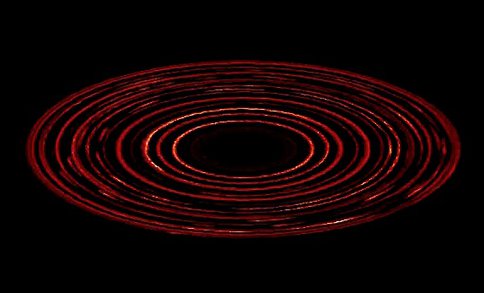2012 Annual Science Report
 NASA Goddard Space Flight Center
Reporting | SEP 2011 – AUG 2012
NASA Goddard Space Flight Center
Reporting | SEP 2011 – AUG 2012
Rings in Debris Disks: A Signature of Planets or of Volatiles?
Project Summary
Marc Kuchner and his collaborator Wladimir Lyra at JPL have developed a new explanation for the origin of eccentric rings in debris disks—like the rings around Fomalhaut and HR 4796. A popular explanation for these rings is that they represent dust shepherded by extrasolar planets, which are often too faint to see. Instead of hidden planets, Kuchner and Lyra’s models invoke a hidden component of gas in these disks, which supports a thermal instability that causes the dust to clump together in narrow eccentric rings. The presence of this instability makes inferring the presence of exoplanets more difficult, but it may aid in planet formation and provide important clues to the history of volatiles in the solar system.
Project Progress
Marc Kuchner and his collaborator Wladimir Lyra at JPL have developed a new explanation for the origin of eccentric rings in debris disks-like the rings around Fomalhaut and HR 4796. A popular explanation for these rings is that they represent dust shepherded by extrasolar planets, which are often too faint to see. Instead of hidden planets, Kuchner and Lyra’s models invoke a hidden component of gas in these disks, which supports a thermal instability that causes the dust to clump together in narrow eccentric rings.
The presence of this instability has several important astrobiological ramifications. First, it shows that inferring the presence of outer planets from patterns in debris disks may be more subtle than previously understood. Second, since this mechanism causes dust to clump, it may aid in planet formation. Third, this instability is apparently signpost of gas in debris disks, analogs of the Kuiper belt at age 10-200 Myr, an important clue to the history of volatiles in the solar system.
Kuchner and Lyra ran their simulations using a hydrodynamic grid code called the PENCIL code. Their paper has been submitted to Nature.
Marc Kuchner and his graduate student Erika Nesvold have continued developing SMACK, a new tool for modeling the collisional evolution and 3-D distribution of planetesimals in planetary systems and debris disks. We plan to use this tool for interpreting images of planetary systems: modeling images and other data on circumstellar disks. We also expect to use our new models to understand the evolution of planetesimals in the solar system. For example, a popular model for the dynamics of the Kuiper Belt and other small bodies in the solar system is the “Nice” model, which posits that the giant planets migrated through a configuration where Jupiter and Saturn were in a 2:1 resonance. This model has ben explored in detail with n-body models, but never with models that incorporate collisions. Our new technique should allow us to constrain the Nice model to a variety of data that it hasn’t been properly compared to before: KBO size distributions, for example. This step will be important for understanding the delivery of water to terrestrial planets by the planetesimals.
This year, we ported SMACK to the NASA supercomputers, and completed most of the key numerical tests, showing that it can conserve angular momentum, and that the viscosity is small enough to use the code for simulations lasting hundreds of Myr. We will begin applying it to new astrophysical systems this winter.
Kuchner continues to serve as a disk modeler for several observing teams: the Keck Interferometer Nuller key science program, the NICI key science team, and a coronagraphic survey of disks using the STIS instrument on Hubble Space Telescope.
A debris disk with a small volatile gas component is unstable—the dust tends to gather into rings like that, which become slightly eccentric and begin to wobble. This mechanism may explain some Hubble Space Telescope images of debris disks that were previously thought to be sculpted by hidden planets.
Publications
-
Currie, T., Rodigas, T. J., Debes, J., Plavchan, P., Kuchner, M., Jang-Condell, H., … Robitaille, T. (2012). KECK/NIRC2 IMAGING OF THE WARPED, ASYMMETRIC DEBRIS DISK AROUND HD 32297. The Astrophysical Journal, 757(1), 28. doi:10.1088/0004-637x/757/1/28
-
Nielsen, E. L., Liu, M. C., Wahhaj, Z., Biller, B. A., Hayward, T. L., Boss, A., … Toomey, D. W. (2012). THE GEMINI NICI PLANET-FINDING CAMPAIGN: DISCOVERY OF A MULTIPLE SYSTEM ORBITING THE YOUNG A STAR HD 1160. The Astrophysical Journal, 750(1), 53. doi:10.1088/0004-637x/750/1/53
-
Roberge, A., Chen, C. H., Millan-Gabet, R., Weinberger, A. J., Hinz, P. M., Stapelfeldt, K. R., … Bryden, G. (2012). The Exozodiacal Dust Problem for Direct Observations of Exo-Earths. Publications of the Astronomical Society of the Pacific, 124(918), 799–808. doi:10.1086/667218
-
Serabyn, E., Mennesson, B., Colavita, M. M., Koresko, C., & Kuchner, M. J. (2012). THE KECK INTERFEROMETER NULLER. The Astrophysical Journal, 748(1), 55. doi:10.1088/0004-637x/748/1/55
-
PROJECT INVESTIGATORS:
-
PROJECT MEMBERS:
Marc Kuchner
Co-Investigator
-
RELATED OBJECTIVES:
Objective 1.1
Formation and evolution of habitable planets.
Objective 1.2
Indirect and direct astronomical observations of extrasolar habitable planets.
Objective 3.1
Sources of prebiotic materials and catalysts
